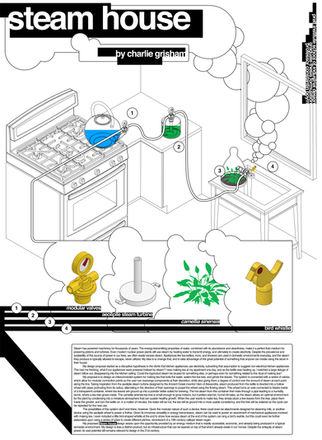Steam House
Steam has powered machinery for thousands of years. The energy-transmitting properties of water, combined with its abundance and cleanliness, make it a perfect fluid medium for powering pistons and turbines. Even modern nuclear power plants still use steam by heating water to transmit energy, and ultimately to create electricity. Despite the prevalence and availability of this source of power in our lives, we often waste excess steam. Appliances like tea kettles, irons, and showers are used in domestic environments everyday, and the steam they produce is typically allowed to escape, never utilized. My idea is to change that, and to take advantage of the great potential of something that anyone can create using the stove in their house.
My design proposal started as a disruptive hypothesis to the cliché that kitchen appliances use electricity, subverting that assumption to suggest non-electrical kitchen appliances. This had me thinking, what if our appliances were powered instead by steam? I was making tea at my apartment one day, and as the kettle was heating up, I watched a large deluge of steam billow out, disappearing into the kitchen ceiling. Could the byproduct steam be reused for something else, or perhaps even for something related to the ritual of making tea?
My proposal is to design an interconnected system for making tea that boils the water, waters the tea tree, and grinds the leaves. The system is connected with a series of valves, which allow for modular connection points so the user can rearrange components at their discretion, while also giving them a degree of control over the amount of steam at each point along the line. Taking inspiration from the aeolipile steam turbine designed by the Ancient Greek inventor Hero of Alexandria, steam produced from the kettle is diverted into a hollow wheel with pipes protruding from its radius, alternating in the direction of their openings to propel the wheel using the flowing steam. This wheel turns an axle connected to blades inside of a transparent container, where tea leaves are ground up into a powder better suited for brewing. The hot steam from this container then rises through a pipe leading to a humidity dome, where a tea tree grows inside. The camellia sinensis tea tree is small enough to grow indoors, but it prefers warmer, humid climates, so the steam allows an optimal environment for the plant by condensing into a miniature atmosphere that can sustain healthy growth. When the user wants to make tea, they simply pluck a few leaves from the tree, place them inside the grinder, and turn the kettle on. In a matter of minutes, the water will be hot, the tea will be ground into a more usable consistency, and the tree will be watered so the cycle can be repeated for the next use.
The possibilities of this system don’t end there, however. Given the modular nature of such a device, there could even be attachments designed for steaming milk, or another device using the aeolipile wheel to power a frother. Given its immense versatility in energy transmission, steam can be used to power an assortment of mechanical appliances involved with making tea. I even included a little bird-shaped whistle at the end to show how excess steam at the end of the system can sing a bird’s warble, but this could even be further elaborated upon using a series of tubes to create different pitches, reminiscent of a 19th century calliope steam organ.
My proposed Steam House design seizes upon the opportunity provided by an energy medium that is readily accessible, economic, and already being produced in a typical domestic environment. My design is less a distinct product, but an infrastructure that can be layered on top of that which already exists in our homes. Despite the antiquity of steam power, its vast potential still remains relevant to design in the 21st century.

